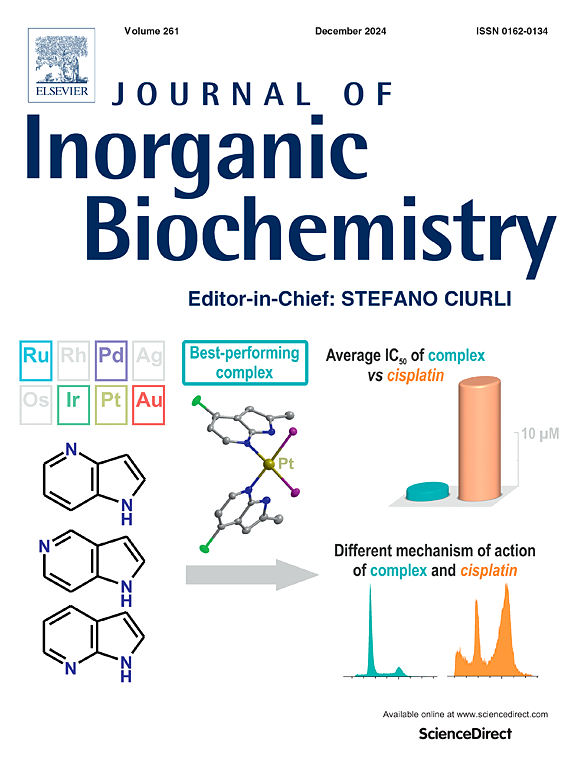HfIV四-(8-羟基喹啉酸)复合物的抗肿瘤和细胞机制
IF 3.2
2区 化学
Q2 BIOCHEMISTRY & MOLECULAR BIOLOGY
引用次数: 0
摘要
通过HfIVCl4与8-羟基喹啉(HL1)、2-甲基-8-羟基喹啉(HL2)和5-氯-8-羟基喹啉(HL3)在THF中反应,合成了3个8-羟基喹啉稳定的铪配合物[HfIV(氧酸盐)4],具有良好的水稳定性和溶解度,收率较高。在合成的复合物中,[HfIV(L1)4]和[HfIV(L3)4]对人肝癌(Hep G2)、宫颈癌(HeLa S3)和肺癌(PC9)细胞系表现出强抑制活性,而对非致瘤性小鼠上皮AML12细胞表现出低毒性。值得注意的是,[HfIV(L1)4]表现出最强的活性,对Hep G2细胞的IC50值为0.8±0.3 μM,比顺铂低17倍(IC50 = 13.8±1.3 μM)。细胞机制研究表明,[HfIV(L1)4]能有效抑制细胞迁移,诱导活性氧的产生,并引起线粒体膜电位破坏。此外,[HfIV(L1)4]在G2/M期阻断细胞周期进程,几乎完全导致Hep G2细胞的早期凋亡。Western blot分析显示,在Hep G2细胞中[HfIV(L1)4]可上调caspase-3和Bax蛋白的表达,下调抗凋亡Bcl-2蛋白的表达,提示凋亡通路是其关键作用机制。与先前报道的[ZrIV(L1)4]进行比较,显示出更高的细胞毒性、细胞摄取、活性氧生成、线粒体损伤和更强的抗氧化酶活性抑制。然而,[HfIV(L1)4]主要诱导早期细胞凋亡,这是有利的。总的来说,这些稀土配合物,特别是[HfIV(L1)4]和[ZrIV(L1)4],作为一种新的抗癌药物,具有很大的潜力,对人类肝癌细胞具有显著的疗效,并具有良好的选择性,可用于进一步的治疗开发。本文章由计算机程序翻译,如有差异,请以英文原文为准。

Anti-tumor and cellular mechanisms of HfIV tetra-(8-hydroxyquinolinato) complexes
Three 8-hydroxyquinoline-stabilized hafnium complexes, [HfIV(oxinate)4], were synthesized with good aqueous stability and solubility by reacting HfIVCl4 with 8-hydroxyquinoline (HL1), 2-methyl-8-hydroxyquinoline (HL2) and 5-chloro-8-hydroxyquinoline (HL3) in THF, achieving high yields. Among the synthesized complexes, [HfIV(L1)4] and [HfIV(L3)4] exhibited potent inhibitory activity against human liver (Hep G2), cervical (HeLa S3) and lung (PC9) cancer cell lines, while showing low toxicity against non-tumorigenic murine epithelial AML12 cells. Notably, [HfIV(L1)4] demonstrated the most potent activity, with an IC50 value of 0.8 ± 0.3 μM against Hep G2 cells, which is 17 times lower than that of cisplatin (IC50 = 13.8 ± 1.3 μM). Mechanistic cell studies revealed that [HfIV(L1)4] could effectively inhibit cell migration, induce reactive oxygen species generation and cause mitochondrial membrane potential disruption. Furthermore, [HfIV(L1)4] blocked the cell cycle progression at the G2/M phase and led almost exclusively to early apoptosis in Hep G2 cells. Western blot analysis revealed that in Hep G2 cells [HfIV(L1)4] could upregulate the expression of caspase-3 and Bax proteins while downregulating the expression of the anti-apoptotic Bcl-2 protein, highlighting the apoptotic pathway as a key mechanism of action. Comparisons are made with previously reported [ZrIV(L1)4], which shows higher cytotoxicity, cellular uptake, reactive oxygen species generation, mitochondrial damage and stronger inhibition of antioxidant enzymes' activity. However, [HfIV(L1)4] induces primarily early apoptosis, which is advantageous. Overall, these rare earth complexes, particularly [HfIV(L1)4] and [ZrIV(L1)4], demonstrate promising potential as novel anticancer agents with significant efficacy against human liver cancer cells and favourable selectivity profiles for further therapeutic development.
求助全文
通过发布文献求助,成功后即可免费获取论文全文。
去求助
来源期刊

Journal of Inorganic Biochemistry
生物-生化与分子生物学
CiteScore
7.00
自引率
10.30%
发文量
336
审稿时长
41 days
期刊介绍:
The Journal of Inorganic Biochemistry is an established international forum for research in all aspects of Biological Inorganic Chemistry. Original papers of a high scientific level are published in the form of Articles (full length papers), Short Communications, Focused Reviews and Bioinorganic Methods. Topics include: the chemistry, structure and function of metalloenzymes; the interaction of inorganic ions and molecules with proteins and nucleic acids; the synthesis and properties of coordination complexes of biological interest including both structural and functional model systems; the function of metal- containing systems in the regulation of gene expression; the role of metals in medicine; the application of spectroscopic methods to determine the structure of metallobiomolecules; the preparation and characterization of metal-based biomaterials; and related systems. The emphasis of the Journal is on the structure and mechanism of action of metallobiomolecules.
 求助内容:
求助内容: 应助结果提醒方式:
应助结果提醒方式:


